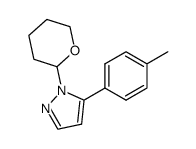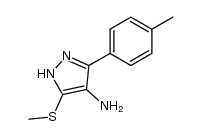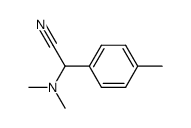59843-75-3
| 中文名 | 3-对-甲苯基吡唑 |
|---|---|
| 英文名 | 5-(4-methylphenyl)-1H-pyrazole |
| 中文别名 |
3-(4-甲基苯基)-1H-吡唑
5-对甲苯基-1H-吡唑 |
| 英文别名 |
MFCD00665963
3-(4-Methylphenyl)-1H-pyrazole 1H-Pyrazole, 3-(4-methylphenyl)- 3-p-tolylpyrazole 1H-Pyrazole, 5-(4-methylphenyl)- 5-p-Tolyl-1H-pyrazole 5-(4-Methylphenyl)-1H-pyrazole |
| 密度 | 1.1±0.1 g/cm3 |
|---|---|
| 沸点 | 343.9±11.0 °C at 760 mmHg |
| 熔点 | 82-86ºC |
| 分子式 | C10H10N2 |
| 分子量 | 158.200 |
| 闪点 | 162.4±12.2 °C |
| 精确质量 | 158.084396 |
| PSA | 28.68000 |
| LogP | 2.68 |
| 蒸汽压 | 0.0±0.7 mmHg at 25°C |
| 折射率 | 1.591 |
| 储存条件 | 密闭于阴凉干燥环境中 |
| 稳定性 | 遵照规定使用和储存则不会分解。 |
| 分子结构 | 1、 摩尔折射率:48.19 2、 摩尔体积(m3/mol):142.5 3、 等张比容(90.2K):372.0 4、 表面张力(dyne/cm):46.4 5、 极化率(10-24cm3):19.10 |
| 计算化学 | 1.疏水参数计算参考值(XlogP):2.2 2.氢键供体数量:1 3.氢键受体数量:1 4.可旋转化学键数量:1 5.互变异构体数量:2 6.拓扑分子极性表面积28.7 7.重原子数量:12 8.表面电荷:0 9.复杂度:139 10.同位素原子数量:0 11.确定原子立构中心数量:0 12.不确定原子立构中心数量:0 13.确定化学键立构中心数量:0 14.不确定化学键立构中心数量:0 15.共价键单元数量:1 |
| 更多 | 1. 性状:无可用 2. 密度(g/mL,25/4℃):无可用 3. 相对蒸汽密度(g/mL,空气=1):无可用 4. 熔点(ºC):82-86 5. 沸点(ºC,常压):无可用 6. 沸点(ºC,5.2kPa):无可用 7. 折射率:无可用 8. 闪点(ºC):无可用 9. 比旋光度(º):无可用 10. 自燃点或引燃温度(ºC):无可用 11. 蒸气压(kPa,25ºC):无可用 12. 饱和蒸气压(kPa,60ºC):无可用 13. 燃烧热(KJ/mol):无可用 14. 临界温度(ºC):无可用 15. 临界压力(KPa):无可用 16. 油水(辛醇/水)分配系数的对数值:无可用 17. 爆炸上限(%,V/V):无可用 18. 爆炸下限(%,V/V):无可用 19. 溶解性:无可用 |
Synonym:None Section 2 - COMPOSITION, INFORMATION ON INGREDIENTS
Risk Phrases: None Listed. Section 3 - HAZARDS IDENTIFICATION EMERGENCY OVERVIEW
The toxicological properties of this material have not been fully investigated. Potential Health Effects Eye: May cause eye irritation. Skin: May cause skin irritation. Ingestion: May cause irritation of the digestive tract. The toxicological properties of this substance have not been fully investigated. Inhalation: May cause respiratory tract irritation. The toxicological properties of this substance have not been fully investigated. Chronic: No information found. Section 4 - FIRST AID MEASURES Eyes: Flush eyes with plenty of water for at least 15 minutes, occasionally lifting the upper and lower eyelids. Get medical aid. Skin: Get medical aid. Flush skin with plenty of water for at least 15 minutes while removing contaminated clothing and shoes. Wash clothing before reuse. Ingestion: Never give anything by mouth to an unconscious person. Get medical aid. Do NOT induce vomiting. If conscious and alert, rinse mouth and drink 2-4 cupfuls of milk or water. Inhalation: Remove from exposure and move to fresh air immediately. If not breathing, give artificial respiration. If breathing is difficult, give oxygen. Get medical aid. Notes to Physician: Section 5 - FIRE FIGHTING MEASURES General Information: As in any fire, wear a self-contained breathing apparatus in pressure-demand, MSHA/NIOSH (approved or equivalent), and full protective gear. During a fire, irritating and highly toxic gases may be generated by thermal decomposition or combustion. Extinguishing Media: Use agent most appropriate to extinguish fire. Use water spray, dry chemical, carbon dioxide, or appropriate foam. Section 6 - ACCIDENTAL RELEASE MEASURES General Information: Use proper personal protective equipment as indicated in Section 8. Spills/Leaks: Clean up spills immediately, observing precautions in the Protective Equipment section. Sweep up or absorb material, then place into a suitable clean, dry, closed container for disposal. Provide ventilation. Section 7 - HANDLING and STORAGE Handling: Wash thoroughly after handling. Use with adequate ventilation. Avoid contact with eyes, skin, and clothing. Keep container tightly closed. Avoid ingestion and inhalation. Storage: Store in a tightly closed container. Store in a cool, dry, well-ventilated area away from incompatible substances. Section 8 - EXPOSURE CONTROLS, PERSONAL PROTECTION Engineering Controls: Use adequate ventilation to keep airborne concentrations low. Exposure Limits CAS# 59843-75-3: Personal Protective Equipment Eyes: Wear appropriate protective eyeglasses or chemical safety goggles as described by OSHA's eye and face protection regulations in 29 CFR 1910.133 or European Standard EN166. Skin: Wear appropriate protective gloves to prevent skin exposure. Clothing: Wear appropriate protective clothing to prevent skin exposure. Respirators: A respiratory protection program that meets OSHA's 29 CFR 1910.134 and ANSI Z88.2 requirements or European Standard EN 149 must be followed whenever workplace conditions warrant respirator use. Section 9 - PHYSICAL AND CHEMICAL PROPERTIES Physical State: Powder Color: white Odor: Not available. pH: Not available. Vapor Pressure: Not available. Viscosity: Not available. Boiling Point: Not available. Freezing/Melting Point: 82-86 C Autoignition Temperature: Not applicable. Flash Point: Not applicable. Explosion Limits, lower: Not available. Explosion Limits, upper: Not available. Decomposition Temperature: Solubility in water: Specific Gravity/Density: Molecular Formula: C10H10N2 Molecular Weight: 158.20 Section 10 - STABILITY AND REACTIVITY Chemical Stability: Stable at room temperature in closed containers under normal storage and handling conditions. Conditions to Avoid: Incompatible materials, excess heat. Incompatibilities with Other Materials: Oxidizing agents. Hazardous Decomposition Products: Carbon monoxide, oxides of nitrogen, irritating and toxic fumes and gases, carbon dioxide. Hazardous Polymerization: Has not been reported Section 11 - TOXICOLOGICAL INFORMATION RTECS#: CAS# 59843-75-3 unlisted. LD50/LC50: Not available. Carcinogenicity: 3-(4-Tolyl)pyrazole - Not listed by ACGIH, IARC, or NTP. Section 12 - ECOLOGICAL INFORMATION Section 13 - DISPOSAL CONSIDERATIONS Dispose of in a manner consistent with federal, state, and local regulations. Section 14 - TRANSPORT INFORMATION IATA Not regulated as a hazardous material. IMO Not regulated as a hazardous material. RID/ADR Not regulated as a hazardous material. Section 15 - REGULATORY INFORMATION European/International Regulations European Labeling in Accordance with EC Directives Hazard Symbols: Not available. Risk Phrases: Safety Phrases: S 24/25 Avoid contact with skin and eyes. S 28A After contact with skin, wash immediately with plenty of water. S 37 Wear suitable gloves. S 45 In case of accident or if you feel unwell, seek medical advice immediately (show the label where possible). WGK (Water Danger/Protection) CAS# 59843-75-3: No information available. Canada None of the chemicals in this product are listed on the DSL/NDSL list. CAS# 59843-75-3 is not listed on Canada's Ingredient Disclosure List. US FEDERAL TSCA CAS# 59843-75-3 is not listed on the TSCA inventory. It is for research and development use only. SECTION 16 - ADDITIONAL INFORMATION N/A |
|
生态学数据: 该物质对环境可能有危害,对水体应给予特别注意。
|
|
~86% 
59843-75-3 |
| 文献:Gerard, Anne-Laure; Bouillon, Alexandre; Mahatsekake, Clement; Collot, Valerie; Rault, Sylvain Tetrahedron Letters, 2006 , vol. 47, # 27 p. 4665 - 4669 |
|
~9% 
59843-75-3 |
| 文献:Journal of the Chemical Society, Perkin Transactions 1: Organic and Bio-Organic Chemistry (1972-1999), , p. 1945 - 1950 |
|
~% 
59843-75-3 |
| 文献:Chemistry of Heterocyclic Compounds, , vol. 38, # 6 p. 668 - 676 |
|
~% 
59843-75-3 |
| 文献:Synthesis, , # 6/7 p. 690 - 691 |
|
~% 
59843-75-3 |
| 文献:Synthesis, , # 6/7 p. 690 - 691 |
|
~% 
59843-75-3 |
| 文献:Synthesis, , # 6/7 p. 690 - 691 |
|
~% 
59843-75-3 |
| 文献:Journal of Organic Chemistry, , vol. 70, # 19 p. 7530 - 7536 |
|
~% 
59843-75-3 |
| 文献:Synlett, , vol. 1997, # 8 p. 959 - 961 |
| 上游产品 3 | |
|---|---|
| 下游产品 0 | |










